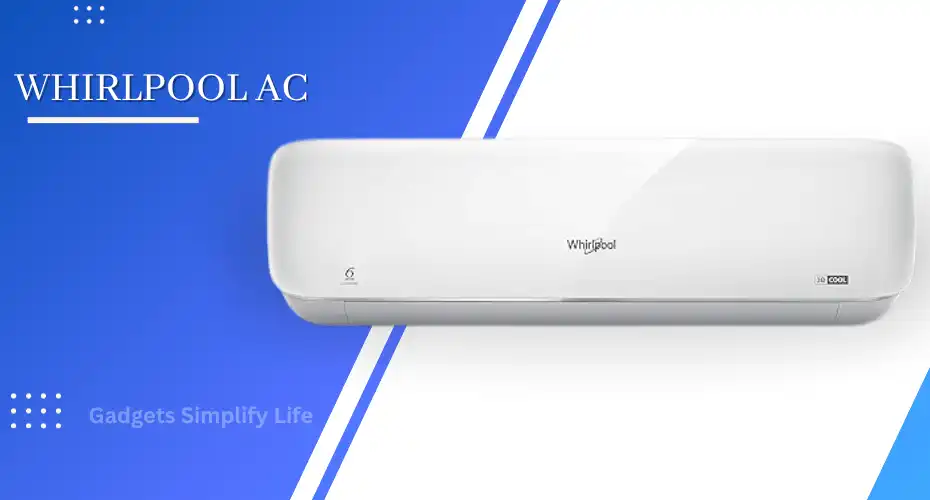Whirlpool AC
Table of Contents
ToggleIntroduction to Whirlpool Air Conditioners
Brief history of Whirlpool Corporation
Whirlpool Corporation, an American multinational manufacturer of home appliances, has a rich and fascinating history dating back to its inception in 1911. Founded by Louis Upton and Emory Upton in Benton Harbor, Michigan, initially as the Upton Machine Company, it began by producing electrically powered washing machines.
Throughout the decades, Whirlpool has continually evolved and expanded its product line, becoming one of the most prominent names in the appliance industry. In 1947, the company rebranded itself as Whirlpool Corporation, reflecting its growing range of home appliances beyond just washing machines.
Over the years, Whirlpool has achieved numerous milestones and innovations, solidifying its position as a leader in the market. From introducing the first automatic washer with a spin-dry feature in 1948 to pioneering advancements in energy-efficient appliances, Whirlpool has consistently pushed the boundaries of innovation and technology.
The acquisition of other well-known brands, such as KitchenAid, Maytag, and JennAir, further expanded Whirlpool’s portfolio and global reach. Today, Whirlpool Corporation operates in over 170 countries, with manufacturing facilities and research centers worldwide.
Despite facing challenges and undergoing changes in leadership over the years, Whirlpool Corporation has remained steadfast in its commitment to quality, innovation, and customer satisfaction. Its legacy of excellence continues to shape the future of home appliances, including its highly regarded line of air conditioners, known for their reliability, performance, and cutting-edge features.

Understanding the Whirlpool AC Product Line
Key features and technologies offered by Whirlpool air conditioners
Whirlpool air conditioners boast an array of key features and cutting-edge technologies designed to provide efficient and reliable cooling solutions. One notable feature is their advanced cooling technology, which ensures rapid and uniform cooling throughout the room, even in extreme temperatures. Additionally, Whirlpool ACs are equipped with energy-saving features such as programmable timers and sleep mode, allowing users to optimize energy consumption and reduce utility bills.
Another standout feature is Whirlpool’s innovative filtration system, which effectively removes dust, pollen, and other airborne particles, ensuring cleaner and healthier indoor air quality. This is particularly beneficial for individuals with allergies or respiratory issues.
Moreover, Whirlpool air conditioners offer convenient and user-friendly controls, including remote operation and smart connectivity options. With Wi-Fi compatibility and smartphone apps, users can easily monitor and adjust their AC settings from anywhere, providing unparalleled convenience and control over their indoor environment.
Furthermore, Whirlpool prioritizes durability and longevity in their products, utilizing high-quality materials and rigorous testing procedures to ensure long-lasting performance. This commitment to quality is reflected in the robust construction and reliability of Whirlpool air conditioners, providing peace of mind to consumers.
In summary, Whirlpool air conditioners stand out for their advanced features, energy efficiency, superior air filtration, user-friendly controls, and durability, making them an excellent choice for those seeking top-notch cooling solutions for their homes or businesses.
Benefits of Using Whirlpool Air Conditioners
Advanced cooling technologies for enhanced comfort
Advanced cooling technologies incorporated into Whirlpool air conditioners are designed to elevate comfort levels in your living spaces. These technologies work tirelessly to ensure that you experience optimal cooling performance, even in the most challenging conditions. One such innovation is Whirlpool’s Turbo Cool feature, which rapidly lowers room temperatures to your desired level, providing instant relief on scorching summer days. Additionally, Whirlpool ACs are equipped with precision temperature control mechanisms, allowing you to set and maintain the perfect climate with utmost precision. Moreover, advanced airflow systems within Whirlpool air conditioners distribute cool air evenly throughout the room, eliminating hot spots and ensuring consistent comfort across every corner. With these cutting-edge technologies at your disposal, you can trust Whirlpool air conditioners to deliver unparalleled cooling performance and enhance your overall indoor comfort experience.
Installation and Maintenance Tips for Whirlpool Air Conditioners
Proper installation procedures and precautions
Proper installation procedures and precautions are crucial for ensuring optimal performance and longevity of your Whirlpool air conditioner. Before beginning the installation process, carefully review the manufacturer’s instructions provided with your AC unit. Here are some essential steps to follow:
Selecting the Right Location: Choose a suitable location for mounting your AC unit. Ensure it’s away from direct sunlight and heat sources, such as lamps or appliances, to prevent overheating and inefficiency.
Proper Mounting: Use sturdy brackets or mounts to secure the air conditioner in place. Make sure the mounting surface is strong enough to support the weight of the unit and is level to prevent any tilting or instability.
Electrical Connections: Before connecting the unit to power, ensure the electrical supply matches the voltage and amperage requirements specified in the user manual. If necessary, hire a qualified electrician to install a dedicated circuit for your air conditioner.
Proper Drainage: Ensure proper drainage for condensation by installing the provided drainage hose according to the manufacturer’s instructions. Improper drainage can lead to water damage and reduced efficiency.
Sealing and Insulation: Properly seal any gaps around the unit with weather-stripping or caulking to prevent air leaks and maximize energy efficiency. Additionally, insulate any exposed pipes or ducts to prevent heat loss or condensation buildup.
Air Filter Installation: Install the air filter provided with your Whirlpool AC unit according to the manufacturer’s instructions. Regularly clean or replace the filter as recommended to maintain optimal airflow and indoor air quality.
Final Checks and Testing: Before powering on the unit, double-check all connections and ensure there are no obstructions blocking the airflow. Once installed, test the air conditioner to ensure it’s cooling effectively and check for any unusual noises or vibrations.
In addition to following these installation procedures, it’s essential to take proper precautions to ensure safety during the installation process:
Turn Off Power: Always turn off the electrical power supply to the installation area before beginning any work to prevent the risk of electric shock.
Use Personal Protective Equipment (PPE): Wear appropriate safety gear, such as gloves and safety glasses, when handling tools or equipment during installation.
Follow Ladder Safety: If installing the unit at height, use a secure ladder and have someone assist you to prevent falls or accidents.
Refer to Professional Help if Needed: If you encounter any challenges or uncertainties during the installation process, don’t hesitate to seek assistance from a qualified HVAC technician or professional installer.
By following proper installation procedures and taking necessary safety precautions, you can ensure a smooth and successful installation of your Whirlpool air conditioner, allowing you to enjoy cool and comfortable indoor environments for years to come.
Troubleshooting Common Issues with Whirlpool AC Units
Identifying common AC problems
Identifying common AC problems is crucial for ensuring your Whirlpool air conditioner operates smoothly and efficiently. One common issue that many users encounter is inadequate cooling. This could be due to clogged air filters, which restrict airflow and reduce the system’s ability to cool effectively. Another common problem is refrigerant leaks, which can lead to diminished cooling performance and increased energy consumption. Additionally, faulty thermostats can cause erratic temperature control, resulting in discomfort and wasted energy. Another frequent issue is unusual noises, such as banging or squealing, which could indicate loose or damaged components within the unit. Finally, improper installation or sizing of the air conditioner can lead to airflow issues and uneven cooling throughout your space. By being aware of these common problems, you can troubleshoot issues promptly and ensure your Whirlpool AC provides reliable comfort year-round.
Maximizing Efficiency and Performance of Whirlpool Air Conditioners
Tips for optimizing AC settings for energy savings
Optimizing your Whirlpool air conditioner settings can not only help you stay cool and comfortable but also save energy and reduce your utility bills. Here are some valuable tips to maximize energy efficiency:
Set the Thermostat Correctly: Keep your thermostat at an optimal temperature, ideally around 78°F (25°C) during the summer months. Avoid setting it lower than necessary, as each degree lower can increase energy consumption by about 3-5%.
Use the Energy-Saving Mode: Most Whirlpool air conditioners come with an energy-saving mode that helps regulate the cooling cycle and reduce energy usage. Enable this mode whenever possible, especially during peak hours.
Utilize Programmable Thermostats: Take advantage of programmable thermostats to adjust the temperature settings based on your schedule. Set it to raise the temperature when you’re away from home or asleep to minimize energy waste.
Use Fans to Supplement Cooling: Ceiling fans or portable fans can help circulate cool air more efficiently, allowing you to set the thermostat slightly higher while still feeling comfortable. Remember to turn off fans when you leave the room to save energy.
Close Blinds and Curtains: Direct sunlight can significantly increase the temperature inside your home, forcing your AC to work harder. Keep blinds, curtains, or shades closed during the hottest parts of the day to block out the sun’s heat and reduce the load on your air conditioner.
Seal Leaks and Insulate: Check for any leaks or gaps around windows, doors, and ductwork that could let cool air escape or hot air in. Proper insulation and sealing can help maintain a consistent indoor temperature and reduce the workload on your AC unit.
Regular Maintenance: Keep your Whirlpool air conditioner clean and well-maintained to ensure optimal performance. Replace or clean air filters regularly, as dirty filters can restrict airflow and force the system to work harder, consuming more energy.
Schedule Annual Tune-Ups: Professional maintenance checks can identify any issues with your AC unit and ensure it operates efficiently. Schedule a yearly tune-up with a qualified technician to clean coils, check refrigerant levels, and inspect other components for optimal performance.
By following these tips, you can enjoy a comfortable indoor environment while minimizing your energy consumption and lowering your electricity bills with your Whirlpool air conditioner.
Eco-Friendly Practices with Whirlpool Air Conditioners
Eco-friendly features and initiatives in Whirlpool AC units
Whirlpool is committed to incorporating eco-friendly features and initiatives into its air conditioning units, aligning with its dedication to sustainability. One notable aspect of Whirlpool AC units is their energy-efficient operation. These units are designed to minimize energy consumption without compromising on performance, helping homeowners reduce their carbon footprint while also saving on energy bills.
Additionally, Whirlpool integrates environmentally friendly refrigerants into its air conditioners, ensuring that they have a lower impact on the ozone layer and global warming potential compared to traditional refrigerants. By prioritizing the use of these eco-friendly refrigerants, Whirlpool demonstrates its commitment to environmental responsibility and reducing harmful emissions.
Moreover, Whirlpool AC units are often equipped with advanced technologies that further enhance their eco-friendliness. Features such as programmable thermostats, energy-saving modes, and smart sensors contribute to optimized energy usage and reduced environmental impact. These technologies enable Whirlpool air conditioners to adapt to changing conditions and operate more efficiently, ultimately benefiting both consumers and the environment.
Beyond the products themselves, Whirlpool also implements eco-conscious manufacturing processes and packaging materials. By reducing waste and minimizing environmental impact throughout the entire lifecycle of its products, Whirlpool strives to contribute positively to sustainability efforts.
Overall, Whirlpool’s eco-friendly features and initiatives in its air conditioning units demonstrate its commitment to environmental stewardship and providing consumers with energy-efficient cooling solutions that align with modern sustainability standards.
FAQs
Conclusion
In this comprehensive guide, we’ve delved into the world of Whirlpool air conditioners, exploring everything from their inception to their advanced technologies and environmental initiatives. We’ve discussed the various models available, highlighting their key features and benefits, along with factors to consider when making a purchase. Installation and maintenance tips have been provided to ensure optimal performance, while troubleshooting advice offers solutions to common issues. We’ve also examined how Whirlpool ACs stack up against competitors, and provided real-life reviews from satisfied customers. Through FAQs, we’ve addressed common queries, covering topics such as energy efficiency, installation, and maintenance. Ultimately, this guide serves as a valuable resource for anyone considering investing in a Whirlpool air conditioner, emphasizing the brand’s commitment to quality, innovation, and sustainability.
